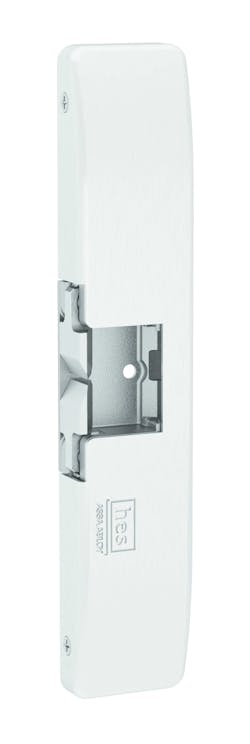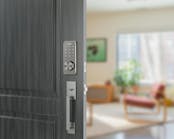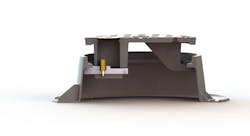Electric strikes were first invented to meet the needs of apartment dwellers. Front entrance doors provided security but that also required tenants to walk down flights of stairs whenever visitors arrived. In its simplist form, an electric strike contains an electromagnet which controls a spring-actuated gate. The gate holds a hinged strike lip in a rigid position. When electricity is supplied to the electromagnet, the magnet retracts the gate and the hinged strike lip is no longer held in a rigid position. The extended lock latch can move the loosened strike lip out of position as the visitor pulls the door open and enters. As soon as electricity is no longer sent to the electric strike, the gate again holds the strike lip in a rigid position and the entrance is secured.
Several restrictions were built into early electric strike designs. Due to the size of most electromagnets, cases containing the operating parts required a large cutout in the door frame. Most electric strikes had to be installed into door frames used with at least a 1 3/4" doors.
Early electric strikes were designed to only accept spring latches and clearance inside the electric strike only allowed for a 1/2" long latch bolt. Vertical lip positions in electric strikes were preset. This caused aftermarket replacement problems when trying to install an electric strike in place of a standard strike plate. No simple adjustments were available if a horizontal adjustment was needed. Locksmiths had to either move the door stop trim or remortise the electric strike to compensate. Locksmiths in the last generation had only approximately one half dozen different electric strike models to choose from and had to find ways to 'make do'.
Most of these problems were solved by electric strike manufacturers after the beginning of the electronic access control era. Electric strikes took on a new purpose when electronic access control became popular. Keypads and card readers were invented so tenants or office workers could quickly gain entrance without waiting for a third party to unlock the door. Manufacturers became aware that electric strikes were an important link in access control systems and continue to increase the scope of available electric strike products to meet industry demands.
The following products are current examples of electric strikes which are available from some popular electric strike manufcturers. For further information on each company contact your local locksmith distributor or see the website listings at the end of this article.
CAMDEN DOOR CONTROLS: Camden Series 20 Pre Load electric strikes offer the highest pre load rating. 'Universal' operations includes 12/24V, AC or DC, selectable fail safe/fail secure settings, adjustable keeper and latch monitoring. Model EZ Fit (tm) fits standard ANSI cutout eliminating need for cutting or drilling. Accepts 1/2" to 5/8" latch projections.
HES: The HES 9600 series is a surface mounted electric strike which is windstorm rated. The strike is designed to operate with rim exit devices which have a 3/4" latchbolt. All components are housed within a 3/4" thick stainless steel lock case. No cutting of the frame is required for installation.
ROFU SECURITY INTERNATIONAL: A new 2435 kit comes complete with five stainless steel face plates. A one-inch keeper depth allows usage with cylindrical, mortise locks or mortise exit devices. Faceplates are reversible for left or right hand installations. These strikes can be installed on wood, metal or aluminum jambs. Deadlatch ramp and deadbolt opening are adjustable. Tested up to 1500 lbs. holding force. Fail safe/ fail secure are field changeable. A trim plate is included in case of cutout errors. Current draw is 250mA/150mA.
RUTHERFORD CONTROLS (RCI): RCI's "all-in-one" 6 series electric strikes can be used on aluminum, cylindrical, centerline mortise locks and exit devices. Features include multi voltage solenoid, selectable lock mode (no tools necessary), horizontal adjustment plus plug-in wire connectors. An optional monitor switch is available. A low profile L65 model is designed for narrow stile aluminum frames and accepts up to a 5/8" latch extension. A standard S65 model accepts latch extions up to 3/4". Three faceplates are included which will retrofit most ANSI cutouts. 6 series is UL listed to 1500 lbs. of Static Strength.
SECURITY DOOR CONTROLS (SDC): Uniflex 55 series universal electric strike from SDC retrofits existing ANSI 4 7/8" strike prep. Uniflex 55 series electric strikes are field reversible for failsafe or failsecure operation. 1/8" horizontal adjustment allows for doors which are out of alignment. Dual voltage setting for 12/24 VDC operation. Stainless steel corrosion resistant parts. Extended length keeper and choice of 6 application face plates allows universal applications for cylindrical locks, mortise latch locks and mortise exit devices.
TRINE: Trine calls their 4000 series electric strikes a "One Box Solution". Flexible functions of their 4200 electric strike include a shallow 1 1/16" case backset measurment for ease of installation in aluminum stiles plus a cavity height of 2 13/16" which is the tallest opening in its class. This added height solves door sag and other alignment problems.
VON DUPRIN: Von Duprin 6300 series electric strikes are designed to operate with a variety of rim exit devices. The 6300 is surface-mounted and easy to install in retrofit situations without modifying or altering the door frame. The 6300 is fail secure (FSE) in compliance with UL10C fire-rated openings. 6300 electric strikes can be set for 12VDC or 24VDC operation. Durable stainless steel construction.
FMI
Camden Door Controls: www.camdencontrols.com
HES: www.hesinnovations.com
ROFU: www.rofu.com
RCI: www.rutherfordcontrols.com
SDC: www.sdcsecurity.com
Trine: www.trineonline.com
Von Duprin: www.us.allegion.com






